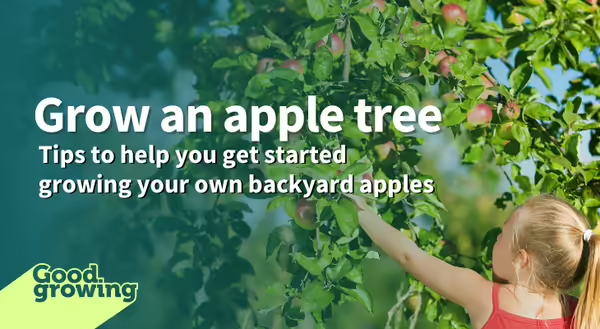
It is late August. Do you know what that means? Apples! Yes, our apple trees are beginning to yield their bountiful fruits. A few days ago, I walked over to a friend's apple tree and pulled down on a low-hanging apple with no signs of blemishes or damage. The fruit slipped off the tree easily, indicating it was ready to be eaten. Using my shirt, I polished the apple removing the dust and grime of the summer to reveal a brilliant sheen reflecting flares of sunlight off the apple’s skin. Biting down I was rewarded with a sweet juicy crunch. Nothing beats a fresh apple off a tree!
I think others have noticed apples in their friend's and neighbor's yards. Several homeowners have reached out to their local Illinois Extension office curious if they too can grow apples. Yes, you can! Following are tips to get started in backyard apple growing.
- Choose disease-resistant apples. This is very important because apples are in the Rose family, which is quite prone to many deleterious diseases. Full sun and good airflow help reduce disease.
- Choose apple scab-resistant trees. Wasn’t that implied in the first bullet point? This disease is so common and frustrating to home apple growers that it deserves its own bullet point. Finding these scab-resistant types usually means an internet search for reputable dealers. More than likely the stuff you buy at the big box store is not resistant to scab. A few scab-resistant varieties are Crimson Crisp, GoldRush, NovaSpy, and Redfree.
- Pick an apple tree on a dwarf rootstock. Unless you like pruning or climbing ladders, an apple tree grafted to a dwarfing rootstock will limit a lot of pruning maintenance and hopefully keep you off the ladders when it is time to pick your apples.
- Do not bury the graft union. Pretty much all apple trees sold today have the top portion which creates tasty apples (a.k.a. the scion) grafted onto a disease-resistant and dwarfing rootstock. The graft union is a swollen area on the lower portion of the trunk. Make sure this is above ground. Just as importantly, make sure you don’t plant the tree too deep. Try to expose the root flare at the base of the tree. Admittedly, sometimes the root flare can be hard to identify with grafted apples.
- Protect the trunk, especially on young trees. In backyards, rodents like voles and deer are often culprits of an apple tree’s demise. Male deer will often rub their antlers on small apple trees. Voles will chew the bark at the base of the tree during long periods of snow cover. Physical exclusion is the best method for preventing damage. Install fencing for the deer and small collars at the base for the rodents. Fencing and collars can be removed in the summer.
- Your apple tree is not able to pollinate itself. That means it needs a different variety of apple or crabapple nearby to produce fruit. Bees and other pollinators are responsible for transporting the pollen from tree to tree therefore the trees should be within 100 feet of each other.
We are just scratching the surface of growing backyard apples. With a little more research and a few years of growing under your belt, you will be inspiring your friends and neighbors to try their hand at growing their own apples. Need more information on starting your backyard orchard? Contact your local Illinois Extension office.
Good Growing Tip of the Week: Some of the newer and tastiest apple trees are licensed and to get a tree you need to be a big-shot apple grower just to get on the waiting list to try them. An example is Cosmic Crisp, which can only be sold to Washington state growers.
Sign up for our emails! Want to get notified when new Good Growing posts are available? SIGN ME UP
MEET THE AUTHOR
Chris Enroth is a horticulture educator with University of Illinois Extension, serving Henderson, McDonough, Knox, and Warren counties since 2012. Chris provides horticulture programming with an emphasis on the home gardener, landscape maintenance personnel, and commercial landscapers. Additional responsibilities include coordinating local county Master Gardener and Master Naturalist volunteers - providing their training, continuing education, advanced training, seasonal events, and organizing community outreach programs for horticulture and conservation assistance/education. In his spare time, Chris enjoys the outdoors, lounging in the garden among the flowers (weeds to most).